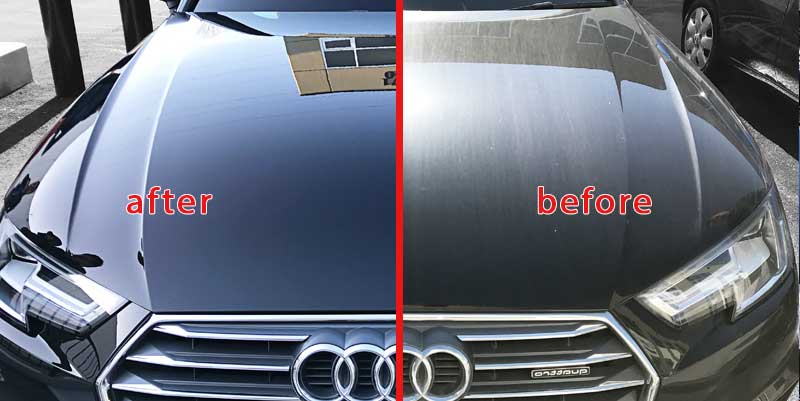Professional Ceramic Coatings San Jose for Superior Gloss and Toughness
Professional Ceramic Coatings San Jose for Superior Gloss and Toughness
Blog Article
Introducing the Science Behind Ceramic Coatings: Exactly How Does It Work and Why Is It Superior to Conventional Choices?
Ceramic finishings have actually been getting popularity in numerous markets for their exceptional performance and longevity. Comprehending just how ceramic finishes work and why they exceed standard choices is critical for those seeking to boost the long life and strength of their materials.
The Chemistry of Ceramic Coatings
In comprehending ceramic layers, diving into the complex chemistry behind their make-up is essential for realizing their capability and resilience. Ceramic finishes are largely composed of silicon dioxide (SiO2), which develops a safety and solid layer when used to various surface areas. This chemical framework supplies phenomenal resistance to warm, chemicals, and deterioration, making ceramic layers very demanded for a vast array of applications.
The chemistry behind ceramic coatings entails the formation of covalent bonds in between silicon and oxygen atoms, developing a rigid network that improves the coating's strength and toughness. Additionally, the presence of other aspects such as zirconium, titanium, and light weight aluminum further enhances the finishing's properties, supplying raised hardness and attachment to surfaces.
Understanding the chemical make-up of ceramic coverings permits for the modification of solutions to fit details requirements, whether it be for automobile, industrial, or property purposes. By harnessing the power of chemistry, ceramic layers remain to pave the means for remarkable security and efficiency in numerous sectors.
Advantages of Ceramic Coatings

As an outcome, ceramic layers make cleaning and keeping surface areas a lot easier and less time-consuming. In general, the wide variety of benefits used by ceramic coatings make them a superior choice contrasted to traditional coating techniques.
Just How Ceramic Coatings Bond
Ceramic layers bond to surfaces with a procedure that entails molecular attachment and chemical interactions. When a ceramic layer is related to a surface, it forms a solid bond by chemically sticking to the surface area at a molecular level. This bond is created through the formation of covalent bonds, which are sturdy and exceptionally solid. The ceramic coating's molecules pass through the pores of the surface area, creating a limited hold that withstands separation.
Furthermore, the chemical communications between the ceramic covering and the surface further enhance the bond. ceramic coatings san jose. These communications enable the ceramic covering to create a continuous and smooth layer externally, supplying excellent protection and navigate to these guys durability. Unlike standard layers that might remain on the surface without completely bonding, ceramic finishings produce an irreversible bond that is immune to chemicals, UV rays, and rough ecological conditions

Fundamentally, the bonding system of ceramic finishings guarantees a lasting and effective protective layer that surpasses traditional layer choices. This superior bond adds to the sturdiness, scrape resistance, and longevity of ceramic finishings, making them a preferred option for numerous applications.
Resilience of Ceramic Coatings
The outstanding longevity of ceramic layers comes from their durable molecular adhesion and chemical communications with surfaces, guaranteeing a sturdy protective layer that exceeds traditional finishing alternatives. When used, ceramic coverings form a solid bond with the substrate, creating a durable obstacle against various environmental stress factors such as UV radiation, chemicals, and abrasions. This bond is so safe that it can endure the rigors of day-to-day use without weakening or weakening quickly.
Unlike standard coatings that may deteriorate with time, ceramic coatings maintain their honesty for an extensive duration, offering durable security for the underlying surface. The strong molecular structure of ceramic layers resists cracking, fading, and peeling, guaranteeing that the surface area remains shielded and aesthetically pleasing for many years to find. This toughness not just decreases the requirement for regular reapplications but also saves time and money over time. In general, the outstanding sturdiness of ceramic finishings makes them a superior choice for protecting a wide variety of surface areas in numerous applications.
Ceramic Coatings Vs. Traditional Alternatives
In contrast to standard finishing approaches, ceramic layers provide a distinct blend of toughness and safety capacities that set them browse around this site apart in numerous surface area defense applications. Typical alternatives such as wax or sealants give a temporary layer of protection that can disappear rapidly, requiring frequent reapplication. On the various other hand, ceramic coverings form a strong bond with the surface area, developing a long-term or semi-permanent obstacle that is highly immune to abrasion, chemicals, UV rays, and severe temperatures.
Moreover, ceramic coatings provide premium hydrophobic properties contrasted to typical coverings. The hydrophobic nature of ceramic coverings triggers water to bead up and roll off the surface, lugging dust and impurities with it. This self-cleaning result assists to maintain the surface area's tidiness and gloss for extended durations, minimizing the need for frequent maintenance.
Additionally, ceramic layers have a thicker layer contrasted to traditional alternatives, offering enhanced scrape resistance and protection versus minor impacts. This resilience makes certain resilient performance and assists preserve the visual charm of the treated surface area for a prolonged period.
Final Thought
Finally, the scientific research behind ceramic finishings hinges on their chemical structure and bonding homes, making them above standard options. The benefits of ceramic finishings consist of enhanced durability and security for surface areas. By understanding just how ceramic finishes job and their advantages over typical options, one can make educated decisions when taking into consideration covering choices for numerous applications.
Unlike traditional coverings that might sit on the surface area without fully bonding, ceramic finishings develop a permanent bond that discover this is resistant to chemicals, UV rays, and harsh environmental conditions.
The outstanding long life of ceramic coverings stems from their robust molecular bond and chemical interactions with surface areas, making sure a durable protective layer that exceeds standard covering options.Unlike conventional coverings that might weaken over time, ceramic layers maintain their integrity for a prolonged duration, giving durable defense for the underlying surface area.In contrast to standard coating methods, ceramic coverings provide a distinctive blend of longevity and safety capacities that establish them apart in different surface defense applications. By understanding how ceramic coatings job and their benefits over standard alternatives, one can make educated choices when thinking about finishing choices for various applications.
Report this page